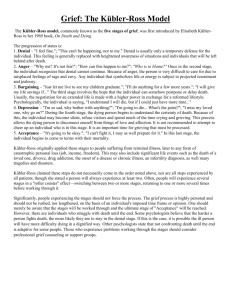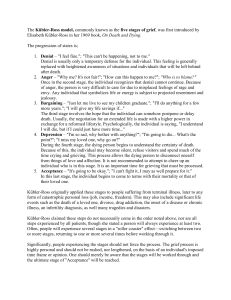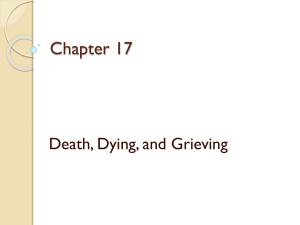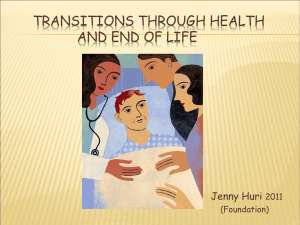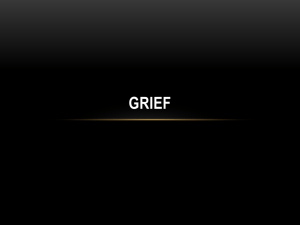Loss,Grief, Dying
advertisement
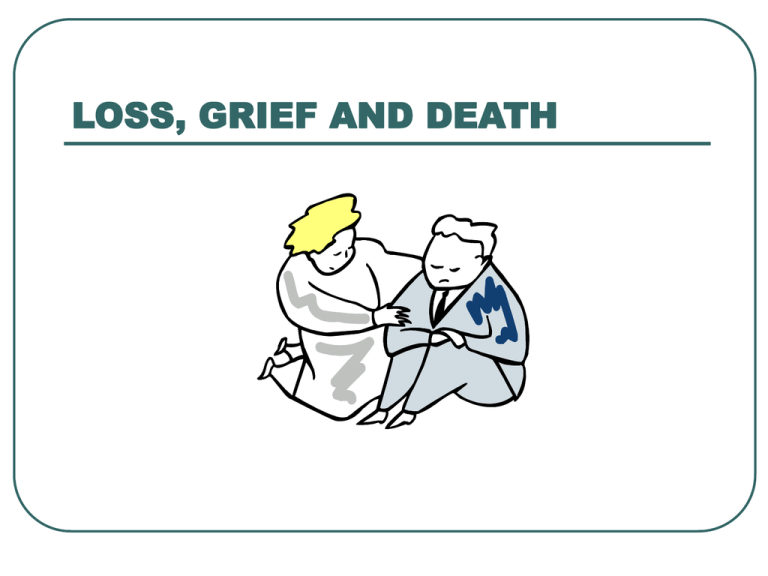
LOSS, GRIEF AND DEATH Loss, Grief, Dying Class Objectives The nursing student will learn: nurses role in loss, grief, death and dying emotional reactions to loss Engles stages of grief Kubler-Ross Grief and Death Reactions legal and ethic dilemmas with death and dying to create a nursing care plan for a death and dying patient. Loss Occurs when a valued person, object, or situation is changed • Actual Loss • Perceived loss • Anticipated loss • Physical loss • Psychological loss Grief or Grieving-Grief is the Emotional Reaction to Loss Bereavement- state of grieving during which a person goes through grief reaction. Mourning-period of acceptance of loss and grief during which the person learns to deal with the loss. Engels 6 Stages of Grief Reaction Shock and disbelief Developing awareness Restitution Resolving the loss Idealization Outcome Kubler-Ross Grief and Death Reactions Denial and isolation Anger Bargaining Depression Acceptance Five Principles of Palliative Care(Hospice care) Respects the goals, likes and choices of the dying pt. Looks after medical, emotional, social, and spiritual needs of the dying person Supports the needs of the family members Helps pt gain access to needed healthcare providers and appropriate settings Builds ways to provide excellent end of life care Ethical and Legal Dimensions Managed death, Legalized physician assisted suicide, Physician administered lethal injections (aid in dying) – create ethical dilemmas. Patients look to nursing for information, advice and support. The nurse patient relationship is key to helping patient’s grieve Advanced Directives Living wills- provide specific instructions about the kinds of health care that should be provided or foregone in a particular situation Durable power of attorney- appoints and agent the person trusts to make decisions in the event of the appointing person’s subsequent incapacity. Do not resuscitate or No code orders What is the difference between a DNR or a No code order and Comfort measures only order? Factors that influence Grief and Dying Developmental Family Socioeconomic Cultural Religious Cause of Death Nursing Process Questions to ask Assessing• What have you been told determine the about your condition? adequacy of the pt’s • Have you had any previous and families, experience with this condition knowledge, or death of a loved one? perceptions, coping • Tell me a little bit about how you are coping strategies and • What is helping you get resources. through this? Nursing Diagnoses Impaired adjustment Caregiver role strain Decisional conflict Ineffective coping Ineffective denial Anticipatory grieving Dysfunctional grieving Hopelessness Ineffective management of therapeutic regimem Planning expected outcomes The pt and family will achieve: • Demonstrate freedom in expressing feelings • Identify and use effective coping strategies. • Accept need for help as appropriate • Make healthcare decisions reflecting personal values and goals. Implementing The nurses aim is to care for the dying pts and their families and promote health and preventing illness of the family Nursing Diagnosis • • • Impaired adjustment r/t newly diagnosed terminal illness Caregiver role strain r/t hospital discharged dying pt because of inadequate insurance. Dysfunctional grieving r/t inability to accept death of infant no grief resolution. Nursing interventions Monitor patient for anxiety Monitor mood changes Communicate willingness to discuss death Encourage pt and family to share feelings about death Monitor pain Facilitate obtaining spiritual support for pt and family Include the family in care decisions and activities as desired. Evaluating The plan of nursing care for dying pts. meets the outcome of a comfortable, dignified death and family members resolve their grief after a suitable time of mourning and resume meaningful life roles and activities. Nurses grieve too. Clinical Signs of Impending Death Muscle weakness Respiratory changes • Cheyne-Stokes • Death Rattle Sensory changes Circulatory changes Postmortem Care Nursing prepares the body for viewing Identification Who to notify Jewelry and valuables Dentures, glasses, prosthetics Question A. B. C. D. A nurse is caring for a pt who is dying of terminal cancer. While assessing the pt. for signs of impending death, the nurse should observe the pt for: Elevated B/P Cheyne-Stokes respirations Elevated pulse rate Flushed skin Question #1 • A nurse caring for a 15 y/o pt with terminal CA has assessed that the pt. is very quiet and has not expressed his feelings. The nurse will need to implement 1. A referral for bereavement resources to enhance care 2. Interventions for a pt in isolation and inner thought 3. Assessment skills to determine fear and anxiety 4. Therapeutic skills to enhance communication Question #2 a. b. c. d. A pt who has ovarian CA with metastasis to the liver complains of increased pain and dysphasia. A physician orders a barium enema. The patient states, “I don’t want this test. What should I do?” The nurse should A inform her to refuse the test Inform the MD of her statements Educate her on the test’s benefits Educate her on the procedure Question #3 a. b. c. d. A 39 y/o pt who is apparently dead is brought to the hospital by ambulance. A concerned neighbor found the pt alone in the apartment in this condition. The tentative cause of death is suicide. Even though the family has refuse an autopsy, an autopsy can be ordered by the A families MD County court City policy dept County coroner. Question #4 1. 2. 3. 4. You overhear a patient state, “If you make me well, God, I will try to be a better person.” You know that this type of statement is one of the stages of grieving known as Anger Bargaining Denial Depression Question #5 The process of viewing the body after death best supports which of the following statements? 1. Provides the resolution of the death experience for most families Increases anxiety levels Allows family members an avenue of escape from the truth Supports the family members’ decision for a DNR 2. 3. 4.
